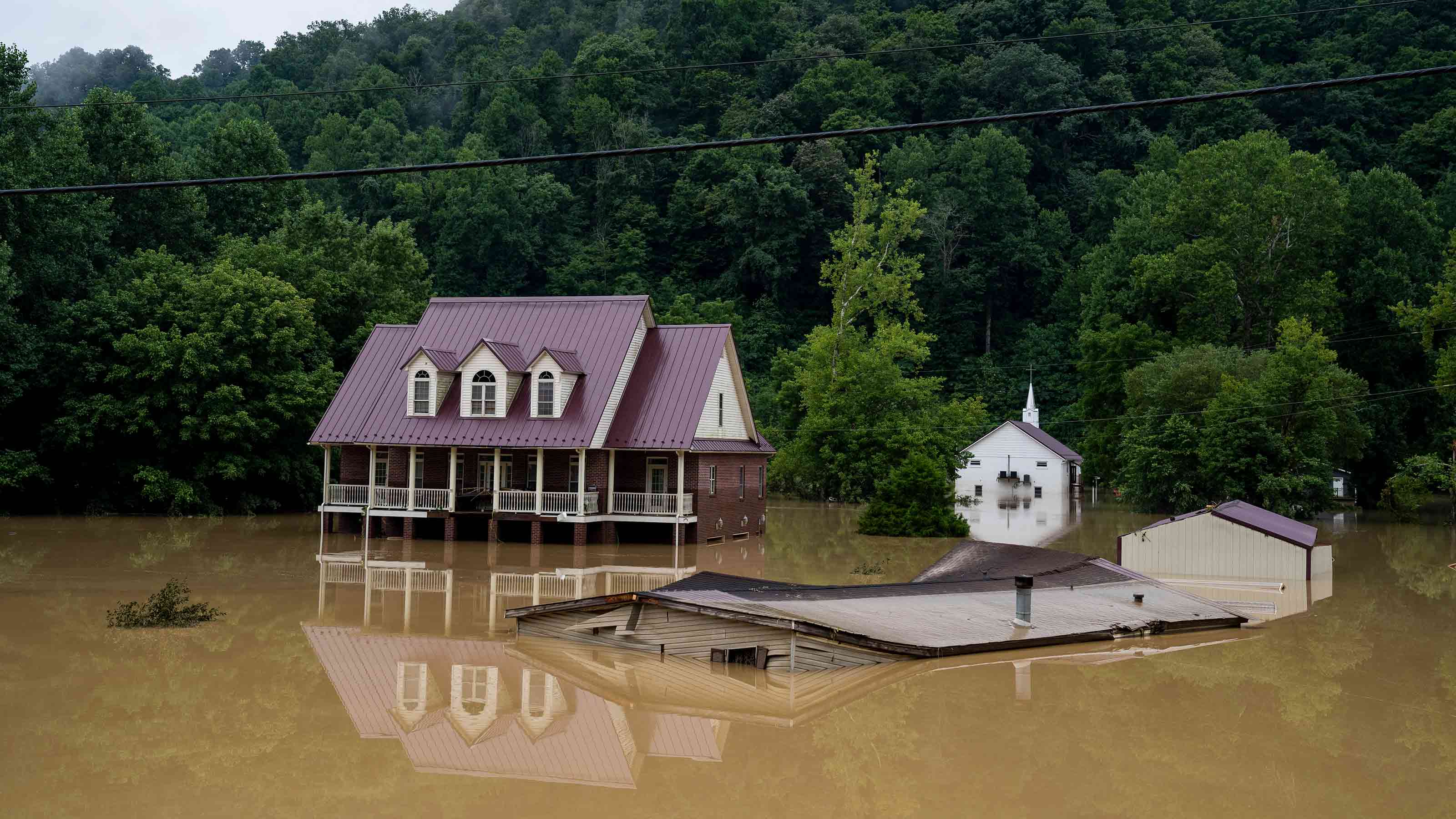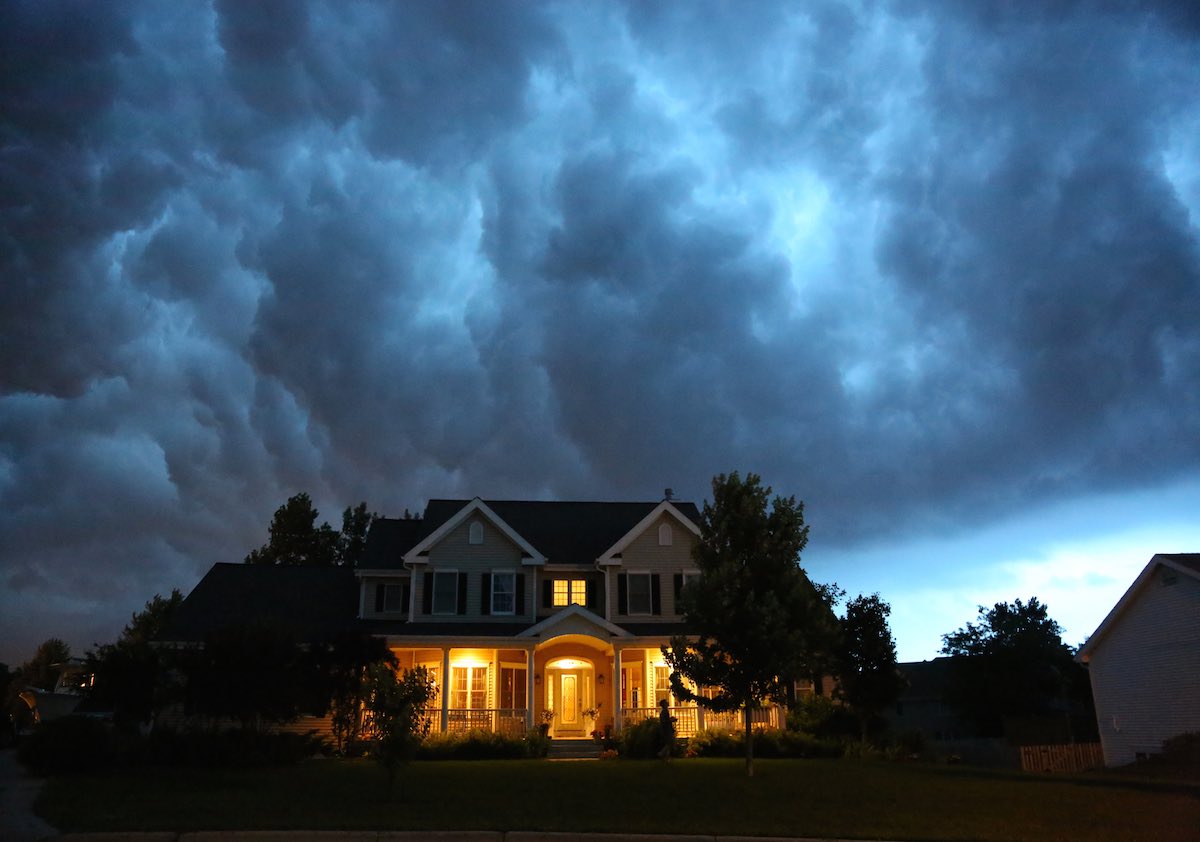How to Protect Your Home from Natural Disasters with the Right Insurance
Not all damage is covered by standard homeowners policies. Make sure you’re prepared for wild fires, floods and other weather events before it's too late.

Donna LeValley
2025 has already been a busy year for weather. Much of the country has experienced frigid temperatures while out west, the Palisades fire causes untold damage.
All told, we are facing the sadly familiar pattern of national disasters in the U.S. In 2024, the National Oceanic and Atmospheric Administration noted there were 24 climate disasters. A disaster is a storm that caused at least $1 billion in damages.
The apparent increase in destructive weather events makes it all the more important that you prepare your home as much as you can to keep it protected. This includes making physical updates to your home as well as preparing coverage, from hurricane insurance claims to flood insurance.

Sign up for Kiplinger’s Free E-Newsletters
Profit and prosper with the best of expert advice on investing, taxes, retirement, personal finance and more - straight to your e-mail.
Profit and prosper with the best of expert advice - straight to your e-mail.
Are you prepared for the next disaster?
Many homeowners have misconceptions about what their home insurance policy will cover, leaving them with unexpected expenses when disaster strikes. For example, when Forbes Advisor surveyed homeowners, 36% of homeowners thought home insurance covers flood-related damage, but it does not.
The survey also found that 40% of homeowners mistakenly thought earthquake damage was covered, too. If you’re at risk for either of those events — or any natural disaster — here’s what you need to know to make sure you’re covered.
Insurance coverage for floods and hurricanes
Certain kinds of water damage are covered by standard homeowners insurance. For example, if your water heater springs a leak or a water pipe inside your house bursts, your home insurance will probably cover the damages after you meet your deductible. (For tips on how to detect leaks early, see below.)
But if it’s any other type of water event, such as flooding from heavy rainfall or a hurricane, you’re on the hook for the costs to repair the damages.
For example, heavy rainfall led to flooding in the basement of Chynna Keys’s home in Fort Washington, Maryland. Keys had to deal with water in her basement a couple of years ago, too, but she thought it had been caused by a faulty sump pump, which she replaced. This time, however, the rainfall flooded not only the main part of her basement but also a back room, damaging the carpet.
Keys called her insurance agent at Erie Insurance, her home insurance provider, only to learn that she was on her own because she didn’t have a separate flood insurance policy. So far, she has paid $5,700 to fix the damages.
What is the National Flood Insurance Program (NFIP)?
Homeowners can purchase flood insurance from the federal government or a private insurer. The government’s National Flood Insurance Program provides up to $250,000 of dwelling coverage and up to $100,000 of contents coverage. The policy has two separate deductibles (one for dwelling, one for contents) that you must pay before coverage kicks in. Deductibles start at $1,000 but can go as high as $10,000 for single-family homes.
If you think this coverage is too low, you can try the private insurance route, which typically has higher coverage limits and will reimburse you for the full replacement cost of your home’s contents. (The NFIP only covers the items’ actual cash value, which includes depreciation.)
The cost of an NFIP policy varies, depending on risk, but averages about $888 a year. A policy from a private insurer is typically higher. However, premiums will vary depending on where you live. For example, if you live close to the beach, premiums for a private policy will probably be higher than average.
Finding private flood insurance

While private companies technically write and manage NFIP flood insurance policies, they're only able to write a limited amount of coverage due to the program's strict underwriting rules.
Private flood insurance, on the other hand, can offer higher limits of protection and additional coverages not offered under the NFIP plan. This includes payments for temporary living expenses — such as hotel stays and restaurant meals — and coverage for personal belongings in your basement. These policy enhancements and coverage for replacing personal property will help to limit your out-of-pocket expenses after a flood loss.
In some areas, a private policy may cost less than one from the NFIP. A 2017 study from Milliman, a risk-management and benefits firm, found that a large number of homeowners in Texas, Florida and Louisiana could buy a policy from a private insurer for less than they’d pay the NFIP. An insurance agent can help you compare options. Search for one near you at Trusted Choice.
Separate wind damage deductible
If you live in a hurricane-prone area, floodwaters aren’t your only concern. While damages from wind and wind-driven rain are covered by a standard homeowners policy, many charge separate wind deductibles, which means higher out-of-pocket costs for you. The deductibles are usually based on a percentage of your coverage rather than a flat dollar amount.
“It has been a gradual shift to different deductibles being applied to wind damage—particularly in the 19 states that are most prone to having hurricanes,” said Dan Karr, founder and CEO of ValChoice, an insurance industry watchdog. “So you could still have a $1,000 deductible on your home, but your wind deductible might be 5% to 10% of your dwelling coverage.”
That can really add up. For example, suppose your home is insured for $500,000 with a 5% wind deductible, and you have $30,000 worth of roof and siding damage from high winds. You’re responsible for $25,000, with your insurance covering only $5,000 of the damages.
Insurance coverage for wildfires
Wildfires have become increasingly common across California and some other western states, bringing with them a slew of insurance woes. Wildfires are covered by standard homeowners insurance, but insurers have been canceling policies in some high-risk areas.
“Over the past several years, as these wildfires have destroyed communities, the insurance carriers have been leaving or declining to provide coverage for those homes,” said Derek Ross, an independent insurance agent in Oak Park, Calif. “So where you may have had five to eight insurance carriers offer insurance coverage in a brush area, now you may be lucky to find one, two or three.”

Ross himself was in the process of shopping for a new policy. Even though he has been with his insurance provider for 15 years and hasn’t filed any claims, the insurer chose not to renew his policy. While he’s not worried about finding a new policy and is prepared to pay for it, he warns that homeowners in a similar situation may face sticker shock when it comes to premiums and deductibles.
For example, deductibles in areas with high brush exposure and other wildfire zones can now run as high as $10,000 or be based on a percentage of your home’s dwelling coverage amount, as is the case with wind deductibles. A policy that may have cost $1,000 a year ago could cost three to six times that much when it’s up for renewal.
Insurance coverage for earthquakes
Earthquake damage is always excluded from standard homeowners insurance policies. You need a separate policy or an endorsement on your current policy to cover direct damages caused by an earthquake.
The deductible for earthquake insurance is usually 10% to 20% of your coverage limit, according to the National Association of Insurance Commissioners. So if your home is insured for $500,000 with a 10% deductible, you could be out $50,000. And depending on how your policy is written, your house, personal belongings and any outside structures could each have their own individual deductible.
Californians can get earthquake coverage from the California Earthquake Authority to cover replacement costs and up to $200,000 of belongings. Deductibles range from 5% to 25%. For more information on CEA policies, go to the California Earthquake Authority website.
Home hardening
In the words of the late University of Alabama football coach Bear Bryant: Defense wins championships. That’s especially true when it comes to preparing your house to withstand anything that nature can throw at it. You can add protection without breaking the bank, and you may get a break on your home insurance premiums, too.
Home hardening addresses the most vulnerable components of your house with building materials and installation techniques that increase resistance to the elements that threaten your home. Whether it's the heat, flames, and embers that accompany most wildfires or the rain and wind that causes much of the damage during hurricanes. there are ways to improve your home's ability to withstand the next extreme weather event.
Flooding. To avoid flood damage, purchase water detectors and install them in your utility closet, said Sean Harper, CEO of Kin Insurance, an online insurance provider. The detectors alert you if there’s a leak by emitting a loud alarm sound, sending a notification to your smartphone, or both.
Some detectors can also be set to shut off your water at the first sign of a home leak. Detectors with automatic water shut-off tend to cost more than those that just sense leaks. One option is the Flo by Moen Smart Water Detector ($50 at Amazon). It is battery-powered and sends notifications to your smartphone through an app.
FEMA recommends that you: clean gutters, downspouts, and splash pads, along with any nearby drainage ditches or storm drains; clear snow and ice away from foundations.
Lastly, consider a sump pump for your basement, A sump pump is the best line of defense against basement flooding, no matter where it came from. These pumps sit in the lowest part of the basement and pump any water out. The sump pump should have a backup power source so that it will continue working even in a power outage. And a monitor can alert you to when water levels rise too high.
Wind. If you live in an area susceptible to hurricanes, tornadoes and other types of windstorms, you need to ensure that your roof is securely strapped down. The best time to add this protection to an existing home is when you replace the roof. A few inexpensive upgrades can make a big difference.
The Insurance Institute for Business and Home Safety’s Fortified standards (which will earn you a premium discount from many insurers) focus on three layers of protection for the roof. The bottom layer — the plywood roof deck — is held on by special “ring shank” nails. The next layer seals the roof deck with a membrane or special tape.
Properly sealed storm-resistant shingles form the top layer. Installing flashing anywhere the roof changes slope also helps. Even if you aren’t replacing the roof, you can add roof straps, metal connectors or retrofit clips in your attic.
Impact resistant window, doors and garage doors can withstand extreme weather conditions. These doors and windows are put through rigorous tests to ensure they won't shatter against high-speed winds or heavy rains.
Wildfires. Homeowners who live in or close to wildfire zones should keep gutters clear of debris, clear out dead plants and shrubs, and remove any dead tree limbs or limbs that are too close to your house. You also want to create what are known as “defensible safe zones” around your property. In the 5-foot area around your home, remove any flammable outdoor furniture and other combustible materials, such as firewood.
Earthquakes. The most common earthquake retrofit braces the “cripple walls” with plywood and bolts the house to its foundation. These walls are usually found on wood-frame homes built before the mid 1970s, and they sit between the foundation and the floor of the house to support the house, creating a crawl space. Even a house without cripple walls may benefit from bolting. Check with your city to see if it has a standard retrofit plan ready for permitting. Look for a licensed, insured contractor with seismic retrofit training from the Federal Emergency Management Agency.
Consider installing flexible gas and water pipe fixtures when it comes to your utilities. They will generally not rupture during an earthquake and you may avoid any gas leaks, water leaks, or fire breakout. Most importantly, install an earthquake-activated shut-off valve on the main gas line into the house. You should know exactly where and how to shut off your gas, water, and electric utilities. And do not keep any flammable liquids in your garage.
When your home is your workplace

In addition to determining whether you have enough coverage to protect your home in the event of a disaster, consider whether the new normal of working from home has changed your insurance needs.
Even if you’ve purchased new technology, your current policy will probably cover the costs if your computer or printer is damaged or stolen. A standard home insurance policy usually provides $2,500 in business equipment coverage. Plus, if you work for someone else, your employer may cover any damages to your work equipment, said Fabio Faschi, a home insurance expert with Policygenius.com.
If you work for yourself and believe existing coverage of your equipment is too low, you can increase it to up to $5,000 for as little as $25 a year, according to the Insurance Information Institute, by purchasing an endorsement that can be added to your homeowners policy.
Living and working at home means your appliances are running more often, so you may want to consider adding equipment-breakdown coverage, Faschi said. With a standard home insurance policy, equipment-breakdown coverage will reimburse you for the costs of mechanical breakdowns, an electrical problem due to a power surge or a problem that stems from faulty installation. It doesn’t cover normal wear and tear. The additional coverage typically costs about $24 a year.
Additional coverage for home-based businesses
Stand-alone business insurance policies can offer more robust coverage and with higher coverage limits. This type of policy can provide better coverage limits for business equipment and liability over a typical home insurance policy endorsement. These policies are good for a business that has visitors coming and going. They are also better than a homeowners endorsement if you have a lot of business property to insure.
In addition to making sure your belongings can be replaced, you’ll want to make sure you’re adequately protected from lawsuits. For example, if someone trips and falls in your driveway, they could sue you to cover the cost of caring for their injuries. Unless you’re meeting coworkers and clients in your home, your current liability coverage, which is typically $100,000, is probably sufficient to protect you from lawsuits.
But for more protection and peace of mind, you can buy an umbrella policy that provides more coverage at a relatively low cost. The first $1 million of coverage generally costs $200 to $400 a year; the next $1 million runs an additional $75 to $100.
Renters need insurance, too
Even though renters don’t have a house to rebuild, they still need to protect belongings that could be destroyed by a fire or another disaster. However, only 37% of tenants have renters insurance, according to recent data from Policygenius.com, an insurance comparison website. If you’re a renter and need a policy, or if you plan to re-shop the one you have, here’s what you need to know.
In general, a renters policy covers three basics: Your liability in the event of lawsuits, replacement of personal possessions, and living expenses in the event your apartment becomes uninhabitable. The policies typically cover losses from burglary, vandalism, windstorms and certain types of water damage. Water damage caused by hurricanes or other weather-related flooding isn’t covered by most renters policies. However, if a pipe bursts inside your apartment and causes water damage, that falls into the accident category, which is usually covered.

A renters insurance policy costs an average of $180 a year, according to Policygenius.com. The price is calculated based on where you live, the amount of coverage you have, your deductible and other factors. Policygenius recommends that renters buy a policy with $30,000 of personal property coverage, $100,000 of liability coverage, and loss of use coverage that’s equal to 40% of personal property coverage. Loss of use means your insurer will pay for you to live somewhere else while your place is being repaired.
If you’re worried about flooding, review your local flood maps to see if you’re at risk. Go to the FEMA Flood Map Service center to find your community flood map. If you live in a community that participates in the National Flood Insurance Program, you may be able to purchase a separate flood insurance policy from the Federal Emergency Management Agency to protect your belongings. Policies start at $99 a year for $100,000 of contents-only coverage.
If you’re concerned about other disasters destroying your belongings, you should consider buying a renters insurance policy with a high personal property limit. Coverage amounts start as low as $15,000 and can go up to $500,000. If you have expensive electronics or jewelry, you may want to add an insurance rider (if one is available) because your standard personal property coverage may not be enough to replace them. Coverage with higher personal property limits is usually inexpensive.
The average cost of renters insurance in the U.S. is $180 a year, or just about $15 a month, according to Policygenius. Premiums can range from a high of $258 to a low of $120. The cost of your renters premium depends on a few things, but a main factor is how much liability coverage and personal property coverage you buy.
Bottom line
There is no substitute for preparation when it comes to a natural disaster. Prepare your home before the wind, rain, fire or quake hits. Improving your home's physical ability to withstand the storm can save you time, agony and money. Checking your insurance and making sure you have coverage for the environmental threats your part of the country suffers will ensure you can rebuild and continue living in the community you call home.
Related Articles
Profit and prosper with the best of Kiplinger's advice on investing, taxes, retirement, personal finance and much more. Delivered daily. Enter your email in the box and click Sign Me Up.

Rivan joined Kiplinger on Leap Day 2016 as a reporter for Kiplinger's Personal Finance magazine. A Michigan native, she graduated from the University of Michigan in 2014 and from there freelanced as a local copy editor and proofreader, and served as a research assistant to a local Detroit journalist. Her work has been featured in the Ann Arbor Observer and Sage Business Researcher. She is currently assistant editor, personal finance at The Washington Post.
- Donna LeValleyRetirement Writer